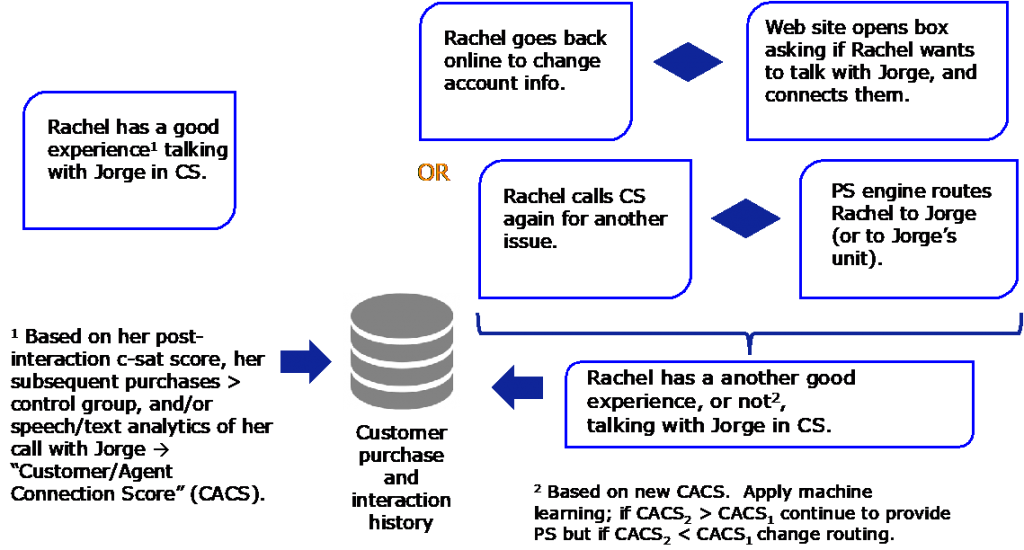Let me start by telling three intersecting stories.
First, back in the 1990s I was leading MCI Call Center Services and beginning to interpret what MCI was doing to attract and retain customers vs. AT&T and Sprint, and among the writings that caught my fancy was the first Peppers and Rogers book The One to One Future: Building Relationships One Customer at a Time 1. In this groundbreaking book and many to follow, Don Pepper and Martha Rogers argued that “A technology-generated “discontinuity” will compel businesses to compete under an entirely different set of rules … 1:1 marketing.” They argued that mass marketing and economies of scale needed to be replaced by differentiation and by “economies of scope”.
Later when I served as Amazon’s first WW VP of Customer Service, I wandered around the floor after meeting with several of the night crew, and I was fascinated by the attention to a complex order by one of the CSRs. Turns out that he had been contacted by a business customer six months earlier because his order for multiple copies of several titles to different addresses was not easy to complete. After this CSR “pushed” that order through the system he offered his personal email address in case the customer encountered problems in the future, and this was one of those problems. When I shared this story the following week with my fellow executives, some of them recognized the customer’s name as one of Amazon’s largest (and most profitable) customers, and agreed that Amazon to make this “pushed” order a new standard feature. This CSRs’ personalized or 1:1 service kept this customer loyal to Amazon, and led to a new solution for other business customers and consumers that enabled them to place these complex orders easily.
Finally, while researching my second book ( Your Customer Rules! Delivering the Me2B Experiences That Today’s Customers Demand2), I ran across a fascinating case where this “Me2B Leader” allowed its sales reps in its contact centers to provide their personal phone extension in case there was any problem with an order, or questions about new products or services. They told me that customers loved this offer and that the sales reps loved being able to continue to conversation with their customers.
Personalized service is good… but does it scale?
What do all three of these stories have in common? First off, they describe a seemingly inefficient customer contact handling process. Instead of routing customers to the “next available agent” based on skills or options chosen in an IVR, each story encourages personalized service and the ability to leverage previous information and conversation. Secondly, they describe incredibly successful companies that tilted windmills and earned lasting customer respect and loyalty. While the second and third stories worked at small scale, both signaled the opportunities if you could harness larger volumes.
However, today very few companies seem to know much about, or follow the tenets of, 1:1 marketing or 1:1 service. Some might argue that this “seemingly inefficient” situation will produce unwanted idle time or overly long calls; others might argue that “any customer to any rep” is the best way to tackle large amounts of demand for support. But as my co-author David Jaffe and I argued in our first book (The Best Service is No Service: Liberating Your Customers From Customer Service, Keep Them Happy, and Control Costs 3), if you “challenge the demand” for service you will benefit customers (less need to contact you and better customer contact experiences), agents or CSRs (less need to handle “dumb contacts” that could be eliminated, or others that could be automated), and the company as a whole (more revenues, more loyal customers, less cost, more sustainable profits).
As Peppers & Rogers forecasted more than 20 years ago, today there is the ability to take advantage of the exciting “technology-generated “discontinuity”” enabled by predictive analytics, and to implement “Personalized Service” solution on a large scale.
Here’s how it can work
After the customer (Rachel) has had a “good experience” with the CSR (Jorge), there’s a positive score for them that the predictive analytics system uses when she goes back online or calls in for another issue, connecting her with the same CSR or with his team if he’s unavailable. The system tracks future positive scores and her subsequent purchases and other indicators of loyalty, and continues to connect her to “Team Jorge” OR to other team if that relationship for some reason sours.
This schematic provides a high-level summary:

What are the benefits?
As with the second and third stories earlier, there are some solid benefits using this Personalized Service solution. One of the larger wireless companies has begun to implement this Personalized Service today, not without challenges since the routing and workforce management systems aren’t built for 1:1 service, and it’s hard to associate scores without a lot of intrusive surveys, but the first returns from them and other pilots are encouraging:
- Shorter handle time for each contact: Less reliance on published “knowledge systems” that are always hard to search, or on “agent notes” from previous contacts that are usually ignored anyway. Less need for customer identification or account validation. Includes time to catch up after the last contact, e.g. “So how did that vacation to Cancun go?” or “Did the last update increase your download speed?”
- Fewer contacts per customer: Anticipate the next issue, and fend off the need to make another contact. Higher “first contact resolution” and “first point resolution”.4 Greater willingness to recommend self-service options for the issues.
- Higher levels of customer satisfaction: As expressed in post-contact surveys, especially open-ended responses enthusing over “You know me, you remember me”2 types of comments, social media posts, and the occasional NPS or Customer Effort Score (CES) surveys.
- Greater spend: Versus a control group that didn’t contact customer service and one that did contact customer service but wasn’t treated to Personalized Service.
Based on all of these desirable benefits, you might ask yourself “Why isn’t every company providing Personalized Service?” First off, it’s hard to pull it off: Most workforce management (WFM) software and “tried and true” customer contact routing/handling tells you that any agent should be able to handle any customer, so you need to question whether this efficiency quest is going to produce the same benefits. Next, you should find out how much you know today about the “Rachels” and their interaction history with the “Jorges”: Have you captured VOC/satisfaction at that 1:1 level and, if so, can you connect these insights to your routing engine? Third, you need to be able to track “downstream” effects of this — or, indeed, any customer contact handling — to see if there are positive results, or not.
One way to tackle Personalized Service is by working closely with your BI (Business Intelligence) team and perhaps a 3rd-party provider of Big Data or other predictive analytics. Ask your WFM and routing system providers what their experience has been with 1:1 interactions, and check around with companies whose services you admire to see how they are tackling this topic. It’s always a good idea to pilot any solution and test the results, and they adjust over time as you expand across your entire footprint.
Notes:
1 Don Peppers and Martha Rogers, PhD. The One to One Future: Building Relationships One Customer at a Time (Doubleday/Currency 1993).
2 Your Customer Rules! Delivering the Me2B Experiences That Today’s Customers Demand (Wiley/Jossey-Bass 2015). Here are the 7 Customer Needs that Lead to a Winning “Me2B” Culture; each Need breaks down into a total of 39 Sub-Needs.
1. “You know me, you remember me”
2. “You give me choices”
3. “You make it easy for me”
4. “You value me”
5. “You trust me”
6. “You surprise me with stuff that I can’t imagine”
7. “You help me better, you help me do more”
3 The Best Service is No Service: How to Liberate Your Customers From Customer Service, Keep Them Happy, and Control Costs Bill Price & David Jaffe (Wiley 2008). Based partly on my years as Amazon’s 1st WW VP of Customer Service, but also on “Best Service” providers around the world who have made it easier for their customers to do business with them, we proposed 7 Drivers that start with “Challenge demand for service”:
1. “Eliminate dumb contacts”
2. “Create engaging self-service”
3. “Be proactive”
4. “Make it really easy to contact your company”
5. “Own the actions across the company”
6. “Listen and act”
7. “Deliver great service experiences”
4 In The Best Service is No Service we introduced the metric “First Point Resolution” or FPR = “Usually expressed as a percentage; customer contacts that are resolved without follow-up by the customer or by the agent to the customer, without resorting to internal transfers, escalations, or support by anyone other than the first agent”



